On a trip to South Africa I was awestruck by the sight of hundreds of incandescent flower spikes glowing in the evening light. They were the flowers of kniphofia, the aptly named red hot poker, and on that visit, I saw many more species, some with pale-lemon flowers, some soft pink but most with the vibrant orange with which the plant is most associated.

Seeing them in their native habitat opened my eyes to the splendour of the genus and how wonderful they might look in a garden setting if grown among ornamental grasses and other southern hemisphere plants rather than the tatty clumps I remember from the suburban gardens of my childhood.
The plant that first grabbed my attention was Kniphofia rooperi, and it remains one of my favourites. The bright-orange flowers are globular rather than elliptical, about the size of a tennis ball. It flowers in September and October, and I grow mine among the deep-blue flowers of Aconitum carmichaelii ‘Arendsii’. Both plants look stunning bathed in the golden light of autumn.
How to grow kniphofia
How to propagate and divide kniphofia
Species kniphofias can be grown from seed, which will germinate quickly if it is fresh. Old seed germinates erratically, if at all. Plants usually flower in the second year after sowing. The easiest way to propagate cultivars is to try to cut off an offset from the base of the plant just as it is starting into growth. Make sure a piece of root is attached. Grow the young plant on in a pot before planting it out into the garden.
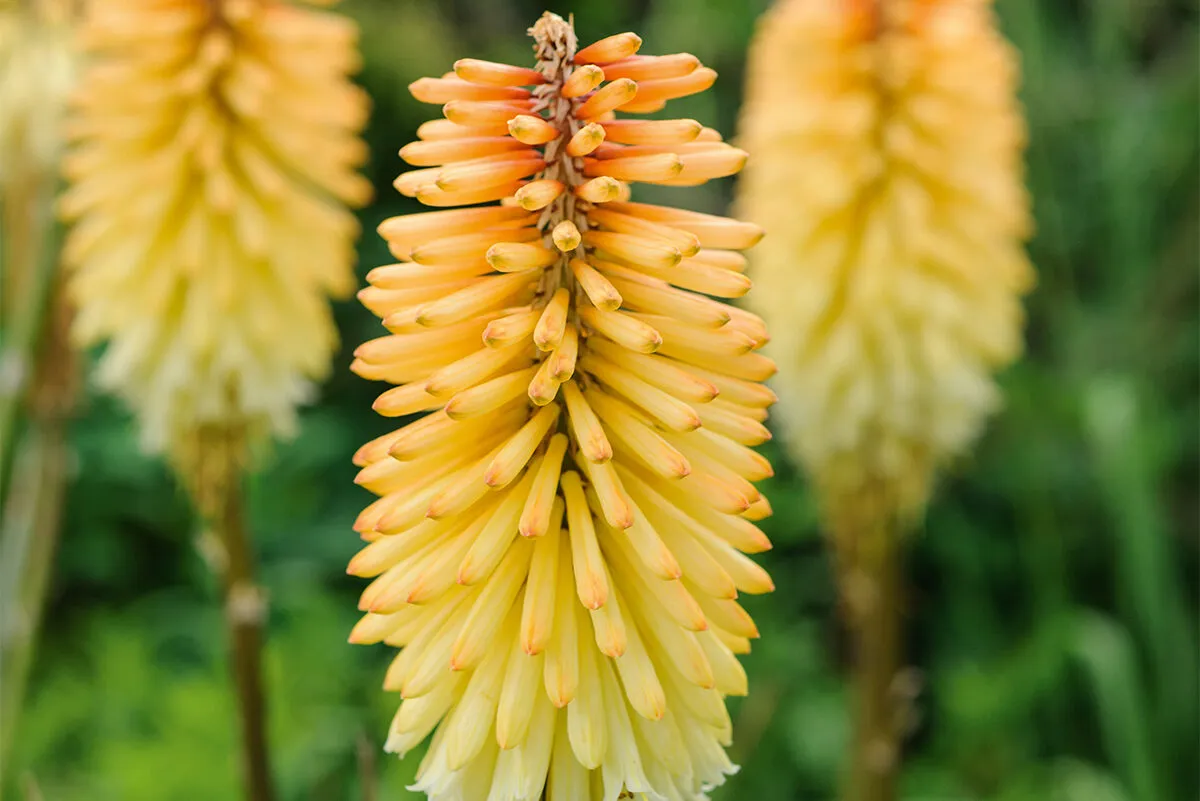
Where to grow kniphofia
In general, kniphofias need lots of sunshine and a free-draining soil. They are not fussy plants and the only thing that they cannot put up with is a soil that is waterlogged during the winter. In the west of the UK, where wet winters are the norm, freezing conditions may cause the crown of the plant to rot but even in southeast England I have lost plants when a freezing cold has followed a wet spell.
Kniphofias will tolerate periods of drought but will not thrive in situations that are permanently dry. Adding compost, manure or some other organic matter to soil that is exceptionally free-draining will help preserve moisture and so help plants flourish.
What to grow with kniphofia
In the garden, kniphofias are as at home in traditional mixed borders as they are in more contemporary prairie-style planting schemes, and the good winter drainage of a gravel garden provides ideal conditions for many. The chunky foliage and thick stems of Kniphofia caulescens, which would suffer in wet situations, is an ideal candidate for gravel gardens. Grown in isolation it is an imposing plant.
The strong vertical line of kniphofia stems are natural companions to ornamental grasses, and I have seen a splendid group of Panicum virgatum ‘Heavy Metal’ threaded among clumps of pale-yellow kniphofias, where the glaucous sheen of the grass almost reflected the bright light of the pokers.

The tropical look of kniphofias lend themselves to exotic gardens where their fiery colours are best seen against the foliage of dark-leaved cannas.
They are an obvious element to hot borders along with dahlias and vibrant crocosmias, but kniphofias are companionable plants that look equally at home with pale achilleas and pastel-coloured phlox. However you grow them, make sure you plant them in large numbers so as to hint at how splendid they look in the wild.
Caring for kniphofia
The foliage of established plants can begin to look tatty. The best way to keep plants tidy is to pull away the old leaves in the spring. A sharp tug should be enough to remove the leaf and at the same time reveal any slugs or snails that are hiding at the base of the leaves. The dying flowers leave behind an unsightly shaggy beard at the top of the flower spike. When they reach that stage, I cut the stem down, as close to the ground as I can get. This also prevents the plant from seeding. Although not a prolific seeder, unwanted seedlings can be tenacious and will need to be dug out.
Many forms are vigorous and can make wide, dense clumps that are too large even for the biggest gardens and will eventually have to be reduced. One technique to keep plants within the space you want them to grow in is to cut away with a sharp knife the new shoots that appear each spring around the edge of the plant. Dealing with clumps that are already too big is hard work and requires cutting into the fleshy centre of the plant with a mattock or spade and digging pieces out.

Kniphofia problems
Kniphofias are relatively tough and trouble-free plants that are not susceptible to disease. Slugs and snails can eat through flower stems, often munching half-way through until, infuriatingly, the stem falls over and the flower is lost. As they emerge, the flower spikes resemble asparagus and seem to attract slugs to their tender stems, so keep an eye out for them as soon as the first shoots appear.
The best kniphofia to grow
Kniphofia rooperi
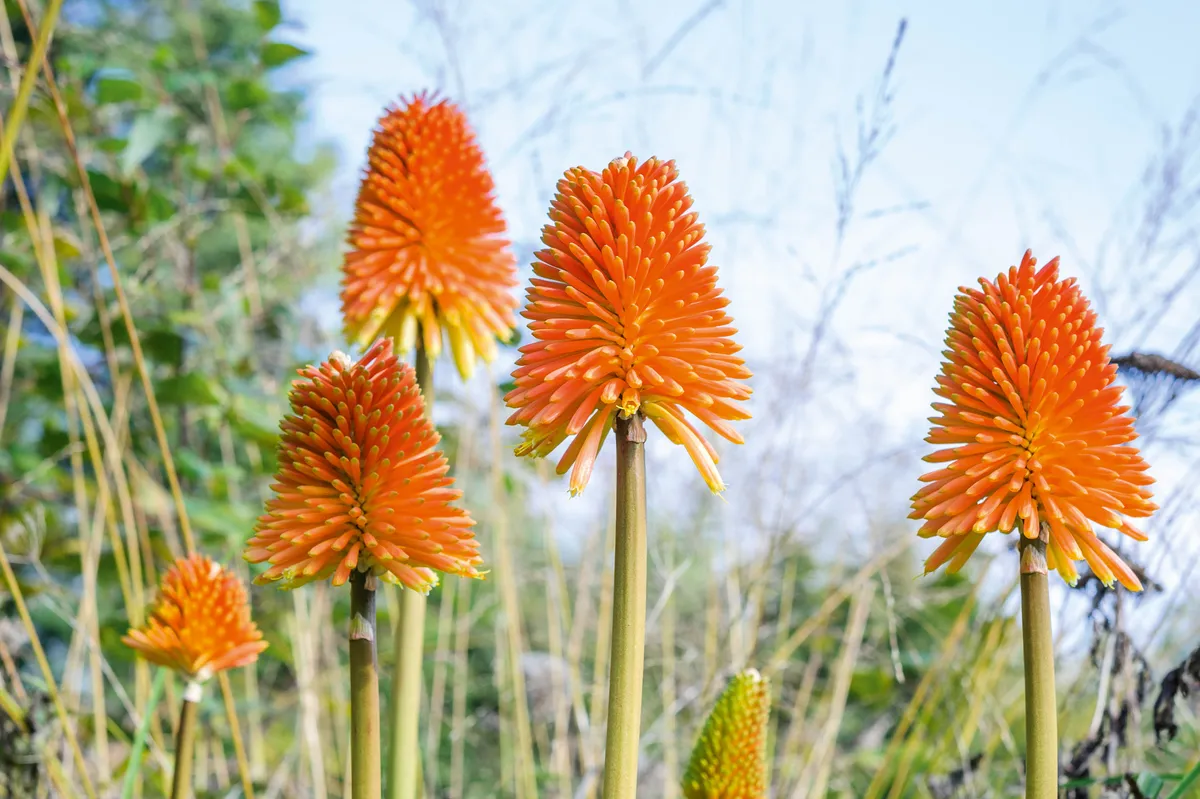
The most widely grown of the species. It has dazzlingly bright, fat, rounded, orange flowers late in the season. Sometimes it doesn’t start flowering until well into October. 1.2m. RHS H5.
Kniphofia ‘Tawny King’

Sumptuous flowers with burnt-orange buds that fade to apricot and open creamy white. The flowers are enhanced by dark-olive stems. Flowers prolifically from July to September. 1.2m. AGM. RHS H5.
PLANT PROFILE
What A genus of about 70 species of mainly evergreen perennial plants with hundreds of cultivars and hybrids. They are grown for their spikes of brightly coloured flowers.
Origins All species are found in areas of high rainfall in eastern and southern Africa, with the vast majority occurring in South Africa.
Season Flowering from April to October; most forms flower in midsummer.
Size From 45cm-2.5m tall.
Conditions Moist soil that drains well in the winter and an open, sunny situation are ideal. Established plants can tolerate periods of drought.
Hardiness Except in very wet areas most are hardy throughout Britain. A few need protection from winter cold and wet. RHS H4-6. USDA5a-9b.
Kniphofia 'Toffee Nosed'
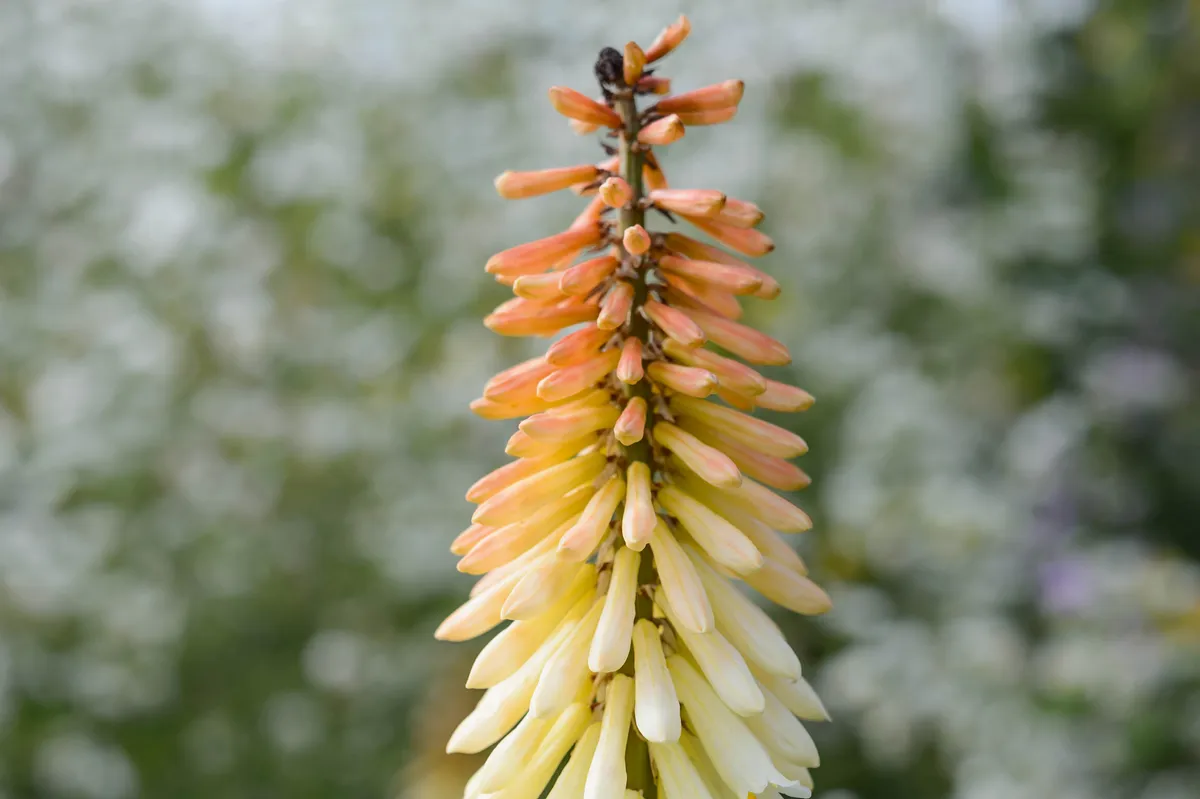
Narrow evergreen leaves which, for a Kniphofia, are almost delicate. The creamy white flowers open from brownish buds, giving a two-tone effect. Introduced in the 1980s by John Metcalf. 1m. AGM. RHS H5.
Kniphofia 'Alcazar'

The flowers keep their narrow, cylindrical shape and uniform orange-red colour and do not fatten or fade as they age. This cultivar was introduced in the 1930s and is still popular. 1m. RHS H5.
Kniphofia ‘Gladness’

The bronze buds turn a coppery orange as they open, eventually fading to cream. It is at its best in June and July, with occasional flowers later in the season. 90cm. RHS H5.
Kniphofia ‘H.E. Beale’

A rare and long-flowering hybrid that starts in early June. The flowers are rounded with apricot buds that open to a clear yellow. Very similar to Kniphofia ‘Ernest Mitchell’. 1.2m. RHS H5.
Kniphofia ‘Percy’s Pride’

A deservedly popular hybrid with luminous flower spikes. The cream buds have a green tinge that becomes paler as the flower opens. It flowers throughout July and August. 1.2m. RHS H6.
Kniphofia 'Timothy'
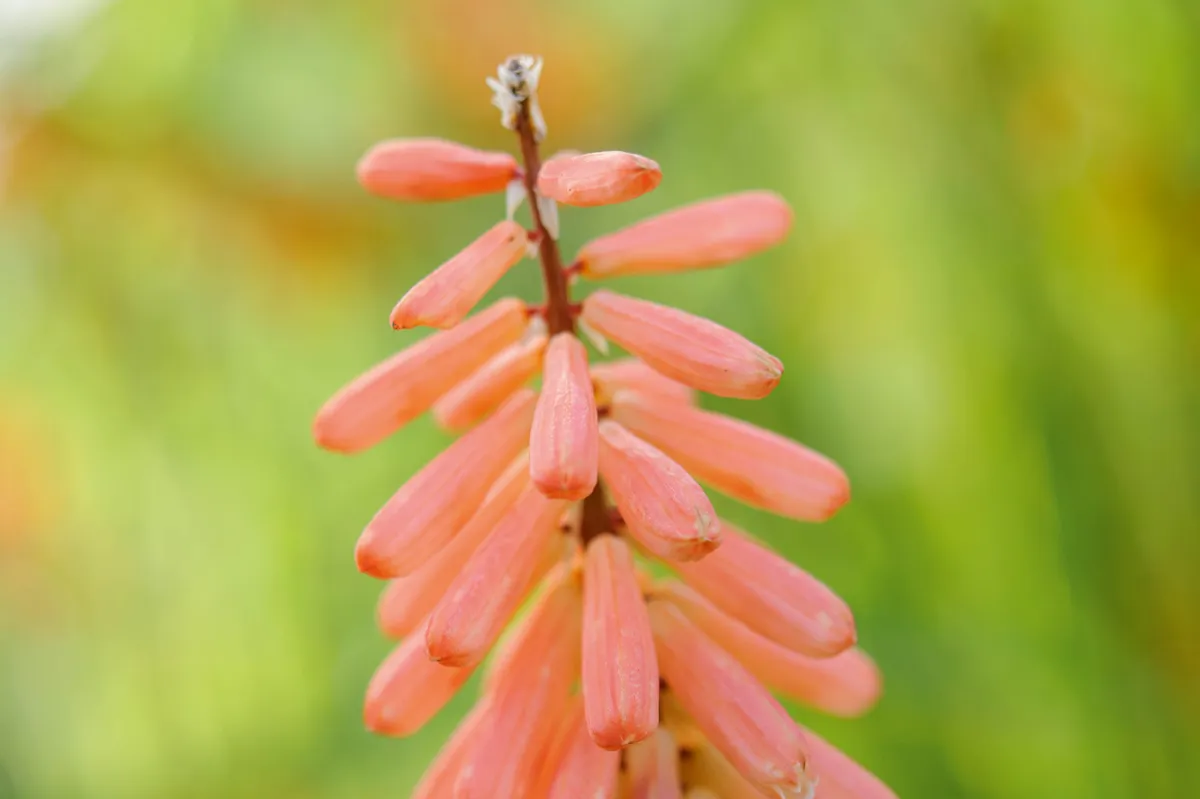
This is a relatively modest plant with none of the swankiness of most kniphofia. The flowers are a uniform salmon colour on bronze stems. It is at its best in July and August. 90cm. AGM. RHS H5.
Kniphofia ‘Green Jade’

A vigorous selection made by Beth Chatto from seed collected by Cedric Morris. The striking, pale-lime flowers fade eventually to white. Gorgeous, but not as floriferous as other pokers. 1.2m. RHS H6.
Kniphofia ‘Scorched Corn’
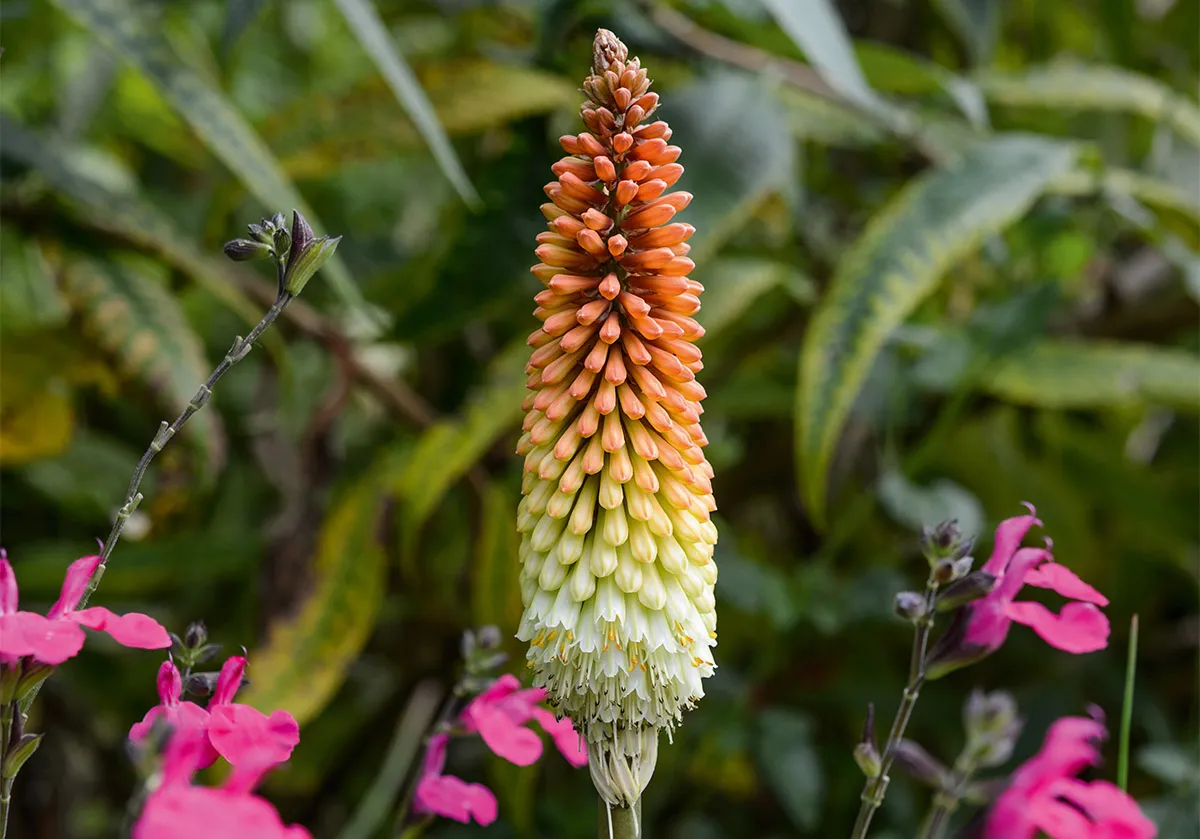
Long, thin tightly packed flowerheads that, if you squint, could be said to resemble corn-on-the cob. The flowers at the top of the spike are tawny-orange and fade to white. 1.5m. RHS H5.
Where to buy and see kniphofia
The best place to see kniphofia in Britain is at the Eden Project in Cornwall, which holds the National Collection. The collection, which includes more than 100 cultivars and 20 species, was established by the outdoor gardening team led by Julie Kendall.
• Eden Project, Bodelva, Cornwall PL24 2SG. Tel 01726 811911, edenproject.com
• The Beth Chatto Gardens, Elmstead Market, Colchester, Essex CO7 7DB. Tel 01206 822007, bethchatto.co.uk
• Claire Austin Hardy Plants White Hopton Farm, Wern Lane, Sarn, Newtown, Powys SY16 4EN. Tel 01686 670342, claireaustin-hardyplants.co.uk
• Cotswold Garden Flowers Sands Lane, Badsey, Evesham, Worcestershire WR11 7EZ. Tel 01386 833849, cgf.net